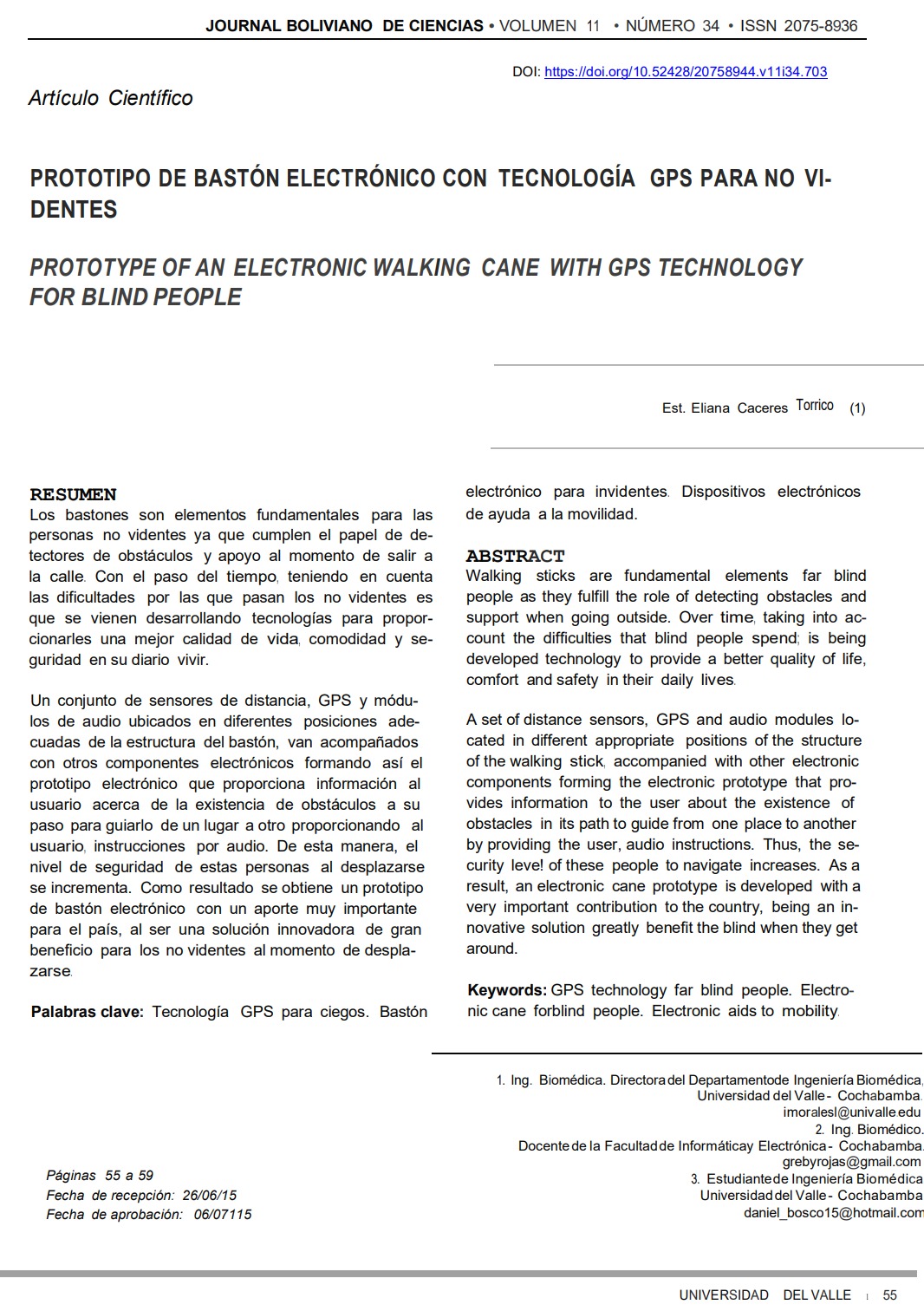Prototype of an Electronic Walking Cane With Gps Technology for Blind People
DOI:
https://doi.org/10.52428/20758944.v11i34.703Keywords:
GPS technology far blind people, Electronic cane forblind people, Electronic aids to mobilityAbstract
Walking sticks are fundamental elements far blind people as they fulfill the role of detecting obstacles and support when going outside. Over time, taking into account the difficulties that blind people spend; is being developed technology to provide a better quality of life, comfort and safety in their daily lives. A set of distance sensors, GPS and audio modules located in different appropriate positions of the structure of the walking stick, accompanied with other electronic components forming the electronic prototype that provides information to the user about the existence of obstacles in its path to guide from one place to another by providing the user, audio instructions. Thus, the security leve! of these people to navigate increases. As a result, an electronic cane prototype is developed with a very important contribution to the country, being an innovative solution greatly benefit the blind when they get around.
Downloads
References
(1) UMH. (2013, Julio 02). SINC La ciencia es noticia. Obtenido de http://www.agenciasinc.es/Noticias/Un-baston-electronico-inteligente-ayuda-a-las-personas-ciegas-a-detectar-obstaculos
(2) Arán. (2012, Abril 15). Conceptos Básicos de Baterías Upo. Obtenido de http://www.cochesrc.com/conceptos-basicos-baterias lipo-tension-capacidad-descarga-y-conexion-de-elementos-a2627. html
(3) Escalé, M. (2013, Julio 03). Bastón para caminar, cómo utilizarlo correctamente. Obtenido de http://suite 101 . net/article/baston-para-caminar-comoutilizarlo-correctamente-a59134#. VljDNjGG8YF
(4) Organización Mundial de la Salud (OMS). (2014). Ceguera. Obtenido de http://www.who.int/topics/blindness/es/
(5) Álvarez, R. (2013, Septiembre 13). TecBolivia. Obtenido de http://tecbolivia.com/index.php/articulosy-tutoriales-microcontroladores/17-como-medir-distanclas-con-el-sensor-ultrasonico-pinq
(6) http://pagina.blogspot.com/2014/03/conectarun-sensor-hc-srüe-con-Ia.htrnl (Marzo, 2014).
(7) http ://articulo. mercadolibre.com. mx/M LM- 463557220-micro-servo-15kg-servomotor-9g-pic-robotíca-atmel-arduino- _JM (Marzo, 2014).
(8) Carletti, E. J. (2014). Servos- Características Básicas. Retrieved from http://robotsargentina.com.ar/MotorServo_basico.htm
(9) http://instructables.com/idNIBROTANK/step3/MOTOR -VIBRADOR/ (Marzo, 2014).
(10) Delgado, A. D. (2012, Agosto). Bastón Blanco para prevenir obstáculos. Obtenido de http://tesis.ipn. m x/x m I u i /bits t re a m /han-dle/123456789/11470/21.pdf?sequence=1
(11) http://banggood.com/WTV020-SD-16P-UD isk-Aud io-Player-S D-Card-M P3-Voice-Module-p-78682.html (Marzo, 2014).
(12) Utronic SA. (2012). Módulos Electrónicos. Retrieved from www.utronic.net
(13) Beck, K. (2013). Desafíos que enfrentan las personas no videntes. Obtenido de http://www.ehowenespanol.com/desafios-enfrentan-personas-videnteslista_ 167084/
(14) http://fr.aliexpress.com/store/group/multi-rotorheli- parts/909398_211322358.html (Marzo, 2014).
(15) BlogElectrónica. (2007, Junio 19). Dispositivos GPS. Obtenido de http://www.blogelectronica.com/mod u los-ch ip-gps-tastrax-ltraxsüü-recepto rI
(16) National lnstruments. (2006, Junio 06). Comunicación Serial. Obtenido de http://digital.ni.com/public.nsf/allkb/039001258CEF8FB686256EOF005888D1
(17) http://hobbylogs.me.pn/?p=17 (Marzo, 2014).
(18) Krauskopf, L. (2012). Cómo elegir y usar un bastón. Buena Salud.

Downloads
Published
How to Cite
Issue
Section
License
Copyright (c) 2015 Eliana Caceres Torrico

This work is licensed under a Creative Commons Attribution 4.0 International License.
Authors who publish with this journal agree to the following terms:
- Authors retain copyright and grant the journal right of first publication with the work simultaneously licensed under a Creative Commons Attribution License 4.0 that allows others to share the work with an acknowledgement of the work's authorship and initial publication in this journal.
- Authors are able to enter into separate, additional contractual arrangements for the non-exclusive distribution of the journal's published version of the work (e.g., post it to an institutional repository or publish it in a book), with an acknowledgement of its initial publication in this journal.
- Authors are permitted and encouraged to post their work online (e.g., in institutional repositories or on their website) prior to and during the submission process, as it can lead to productive exchanges, as well as earlier and greater citation of published work.














